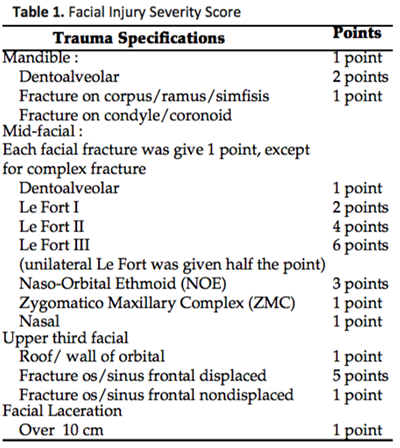Evaluation of Facial Trauma Severity in Cipto Mangunkusumo Hospital Using FISS Scoring System
DOI:
https://doi.org/10.14228/jpr.v1i2.45Abstract
Many scoring systems were introduced to search prognostic value in trauma patients. Facial trauma is a special trauma because it can cause many disabilities in facial function. There have been several reports on facial severity scoring system, such as Facial Injury Severity Score (FISS) and Maxillofacial Injury Severity Score (MFISS). Although these scoring systems have been introduced in many journals, they are not yet used by many clinicians because of their unawareness of its beneficiary. In this study, we want to introduce and apply these scoring systems in our maxillofacial data, thus it can be used for documentation system, as a research tool, and have prediction value for prognosis We retrospectively collected data on patients with facial trauma in Cipto Mangunkusumo Hospital in 2009. The data collected were age, gender, etiology, use of helmet, type of fracture and treatment given. Each patient then evaluated by FISS score to obtain their degree of severity. Using FISS score introduced by Bagheri, we found the average FISS score ini this evaluation was 3,37 ± 1,9, with minimum value 1 and maximum value 9. Most patients have FISS score 2 (24,7%). From FISS scoring system, we found that most of maxillofacial trauma in Cipto Mangunkusumo hospital in 2009 was mild trauma. In order to evaluate if FISS scoring system has predictive value for prognosis, a large sample and complete maxillofacial database are needed.

Downloads
Published
Issue
Section
License

This work is licensed under a Creative Commons Attribution-NonCommercial-NoDerivatives 4.0 International License.
Authors retain the copyright of the article and grant Jurnal Plastik Rekonstruksi the right of first publication with the work simultaneously licensed under a Creative Commons Attribution License. Articles opting for open access will be immediately available and permanently free for everyone to read, download and share from the time of publication. All open access articles are published under the terms of the Creative Commons Attribution-Non-commercial-NoDerivatives (CC BY-NC-ND) which allows readers to disseminate and reuse the article, as well as share and reuse of the scientific material. It does not permit commercial exploitation or the creation of derivative works without specific permission.













